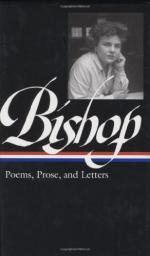|
This section contains 8,251 words (approx. 28 pages at 300 words per page) |

|
“From Gender to Genre and Back: Elizabeth Bishop and ‘The Moose,’” in American Literary History, Vol. 6, No. 2, Summer, 1994.
In the following essay, Blasing explores Bishop's complicated position on feminism and her place among women poets.
Costume and custom are complex. The headgear of the other sex inspires us to experiment.
—Elizabeth Bishop, “Exchanging Hats”
Elizabeth Bishop's refusal to be anthologized and classified as a woman poet is well known; less well known, perhaps, is her statement “I've always considered myself a strong feminist” (“Art” 80). Taken together, these positions suggest that her being a “feminist”—whatever she may mean by it, she is not evading the political issue—does not entail her perceiving her work as a woman poet's, and she demands to be read from this double perspective. Her work is formally traditional: her lines are usually metrical, her stanzas often have intricate rhyme schemes, and her forms...
|
This section contains 8,251 words (approx. 28 pages at 300 words per page) |

|


